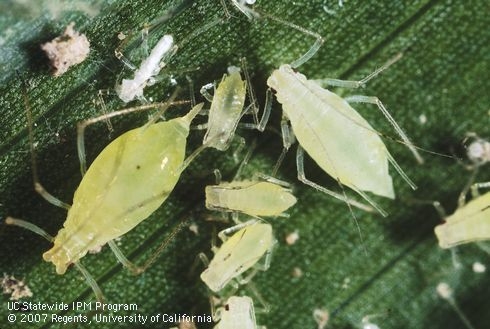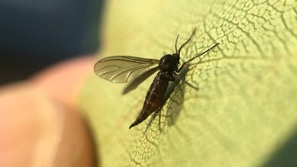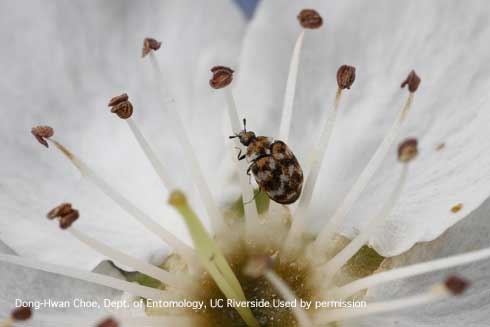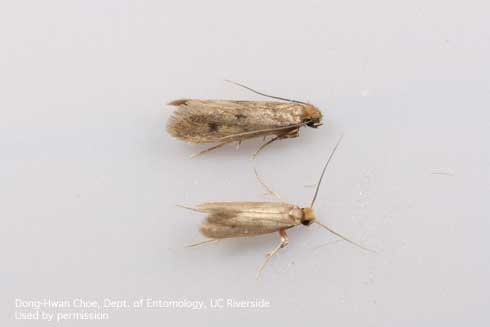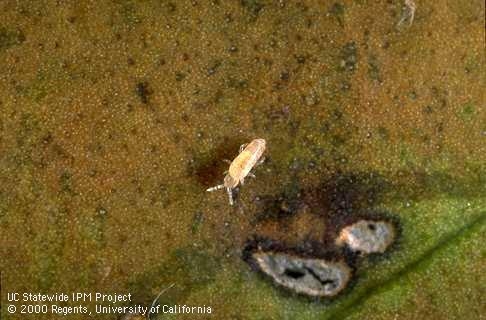We all encounter pests in our homes, gardens, and landscapes, but which ones are most popular in California? While we can't say for certain, website traffic to UC IPM's Pest Notes gives us a glimpse of popular pests. Here are the top ten most frequently viewed publications in 2021.
1. Aphids
These insects may be small, but they can quickly build up large populations. With many different species in California that feed on vegetables, flowers, fruit trees, and woody ornamentals, aphids are a common sight in landscapes and gardens. Year after year, aphids continue to hold the top spot. Learn more about aphids and their management in Pest Notes: Aphids.
2. Fungus Gnats
This pest has become more popular in recent years, perhaps a result from growing numbers of houseplant enthusiasts. Fungus gnats are small flies that often infest soil and potting mix. They can be a common houseplant problem with larvae, or immatures, damaging roots and stunting plant growth when present in large numbers. More information on these frustrating flies can be found in our Pest Notes: Fungus Gnats.
3. Thrips
Another tiny insect sometimes found on houseplants, thrips are slender insects about the size and shape of a dash printed in a newspaper. They suck out the cell contents, leaving a discolored speckling on leaves or stunting plant growth. For more about thrips monitoring and management, visit our Pest Notes: Thrips.
4. Mealybugs
If you've found soft, oval insects that are white in color with wax filaments on your indoor or outdoor plants, it is likely you have mealybugs. These wingless insects are often found in clustered colonies. In yards and gardens, handpicking, pruning, or high-pressure water sprays can reduce populations. For small infestations indoors, spot treatments may help reduce populations. For houseplants with severe infestations, consider disposing of the plant. Find additional information in Pest Notes: Mealybugs.
5. Carpet Beetles
Immature carpet beetles feed on natural fibers such as wool, silk, or furs. The adults may be brought into the home on cut flowers or when they fly in through open doors, windows, or holes in screens. Regular cleaning of rugs, upholstered furniture and can prevent infestations or reduce damage. Check out the Pest Notes: Carpet Beetles for more information.
6. Peach Leaf Curl
Peach leaf curl can affect the blossoms, fruit, leaves, and shoots of peach and nectarine trees. The symptoms of the disease first appear in spring, when distorted red foliage emerges. However, focus management for nonresistant varieties in the late fall and early winter, after leaves drop. Read more about this disease in our Pest Notes: Peach Leaf Curl.
7. Clothes Moths
New to the top ten list this year were clothes moths. These pests tend to hide when disturbed, so you may not realize you have an infestation until after the moths have already damaged fabric, fur, or feathered items. Some clothes moths make webs while others are casemaking moths. Regularly monitoring and cleaning clothing and storage areas can help prevent or reduce infestations. Find more identification and management information from Pest Notes: Clothes Moths.
8. Springtails
Springtails made an unexpected appearance on this year's top ten list. These are small, jumping insects that can be found near kitchen sicks and bathtubs as well as in the soil of indoor houseplants. They often appear in the spring and early summer but can be found year-round in moist environments. They get their name because they jump when disturbed. Learn more about this pest in Pest Notes: Springtails.
9. Whiteflies
Whiteflies are not actual flies but are tiny insects that are often found on the underside of leaves, feeding on the phloem of many different plants. Certain species can cause significant loss in vegetable gardens; other species found in fruit trees are less damaging. Both adult and immature whiteflies also attack houseplants. Management information can be found in Pest Notes: Whiteflies.
10. Scales
Scales are small, legless insects that look like tiny scabs on the stems, leaves, or fruit of plants. While some scale species can weaken a plant when abundant, other species do not appear to damage plants at all. Think you have a problem with these insects? Visit our Pest Notes: Scales for identification and management options.
